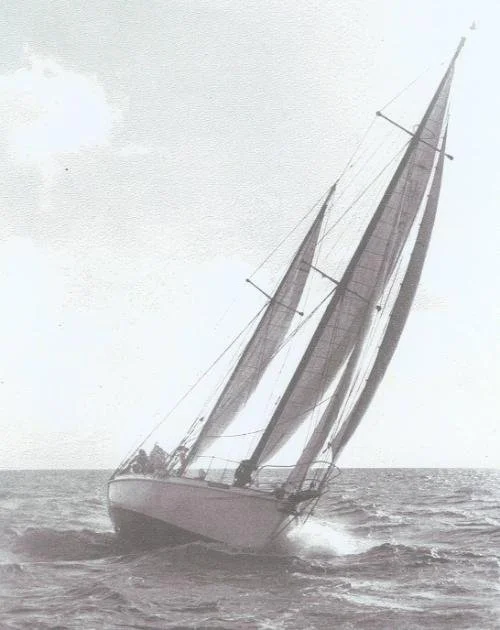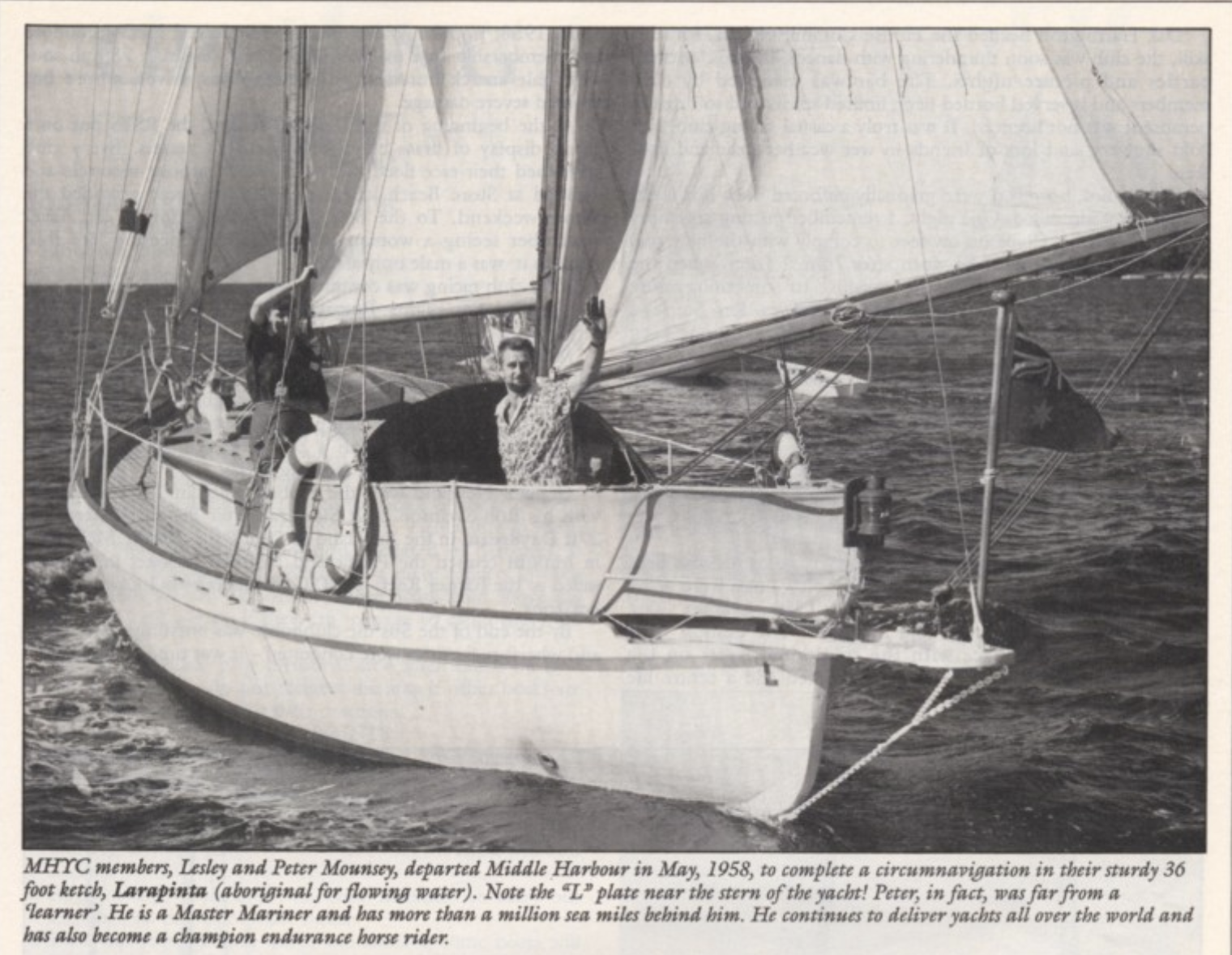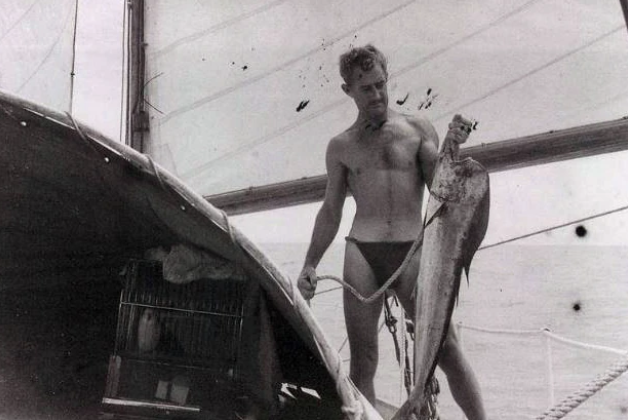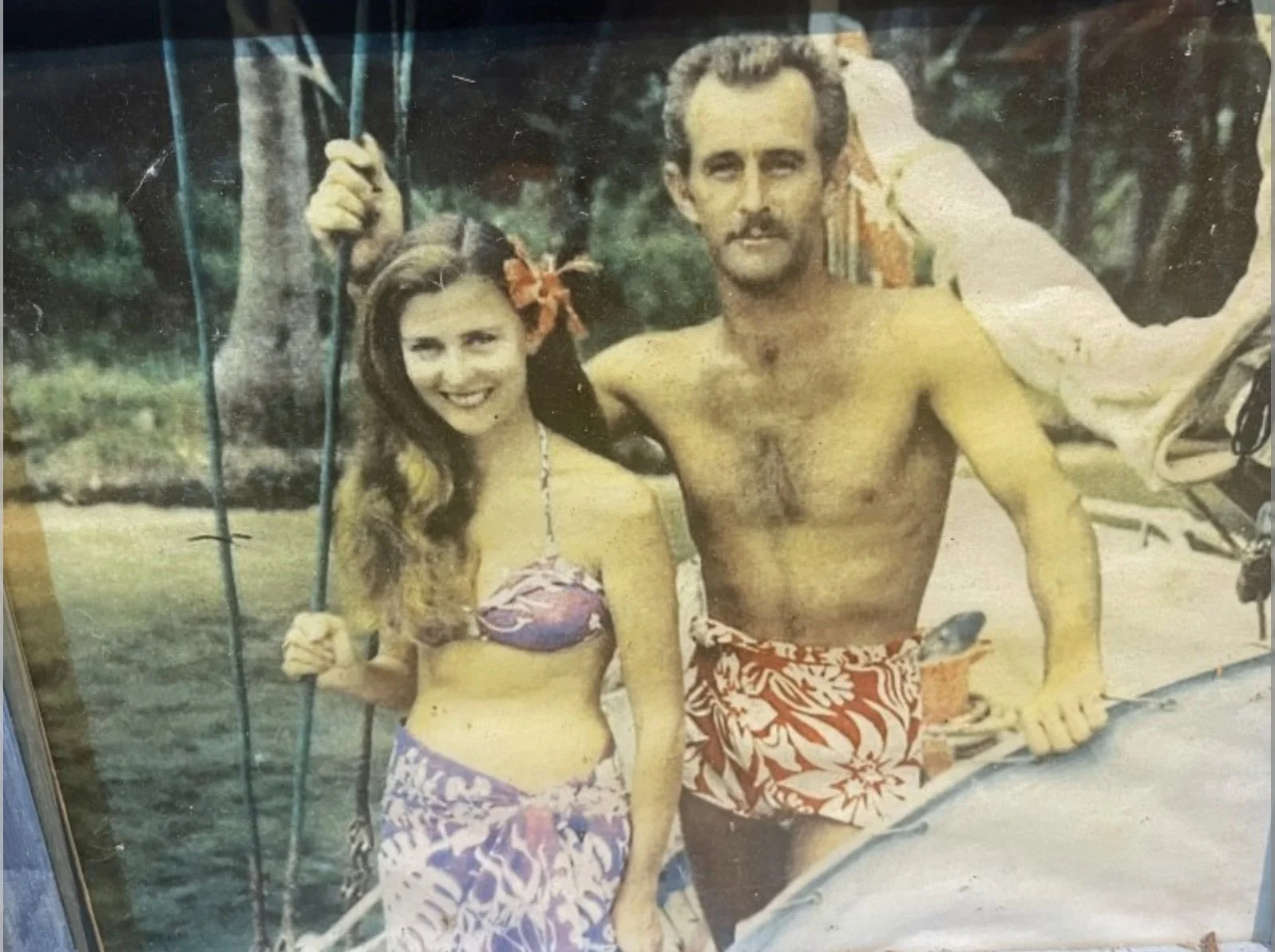Peter Mounsey & the LARAPINTA
We received an email a few weeks back from Rob Wilce, the owner of the classic ketch Larapinta, to say he would be heading to the Timber Boat Festival at RMYC in Pittwater and would we like to run a story on her.
LARAPINTA was originally owned by Peter Mounsey who with his wife Lesley were the first Australian couple to sail around the world. They set out from Sydney in 1958 returning four years later. That’s a story on its own but what really rang all our bells was that the 95 year old Mounsey would be aboard and sailing down from Lake Macquarie with Rob. Back at the helm of LARAPINTA for the first time in sixty one years!
As luck would have it our sometimes Pittwater scribe, Malcolm Lambe, was coming back out from Paris to enter his Laurent Giles ‘Brittany’ class cutter ‘EOS’ in the Festival as well. His report follows.
LARAPINTA as she is today
By Malcolm Lambe
Geeze where do you start with an absolute legend like Peter Mounsey? I must admit I’d never heard of the man nor his boat LARAPINTA. Well he does have twenty-something years on me. When he was setting out to circumnavigate the globe I was learning to sail Sabots, Manly Juniors and VJs at BYRA. He was racing against my boat EOS out of Middle Harbour Yacht Club in the late Fifties and Sixties.
Peter Mounsey is known as ‘The Million Mile Man’ after racking up that many miles and more in yacht deliveries around the world.
He’s done The Admirals Cup and other races in U.K. waters, he’s done nine Hobarts – was navigator aboard the winning “Siandra” in 1958, he’s done a Melbourne to Osaka two handed race, he’s done three solo races from New Zealand, he’s done heaps of harbour and offshore racing - sailing across the Tasman Sea 32 times in small boats. He's done it all.
LARAPINTA, the boat he set out to conquer the world in, was designed by A.C.Barber from lines taken from the "Ingrid" design by William Atkins.
A.C. Barber was a Sydney naval architect who designed RANI the winner of the first Sydney-Hobart in 1946.
There's not too much information of who built LARAPINTA or indeed where she was built. We do know she was launched in 1945 but it's unclear where. Peter Mounsey thought she may have been built in Bermagui but current owner Rob Wilce met an old shipwright who was sure she was built in Rushcutters Bay. From what he can work out the build was started by an amateur but was finished by a professional. Also being after the war building materials were scarce and some sub-standard timber was used. She has spotted gum below the water with oregon topsides. The timber in the stem did have some sap wood which in recent years started to break down needing replacement as shown in the pics.
A number of the frames were not fitted properly during construction and Peter Mounsey tells the story of having to sister many of them while visiting Mauritius.
Peter purchased LARAPINTA around 1955. She still hadn't been finished and needed an internal fit out. Peter and his wife Lesley lived on board in Mosman Bay while the work was completed. They left for their world trip in 1958.
They steered a course up the east coast of Australia, turned west and sailed across the Indian Ocean.
They made landfalls at Christmas Island, The Cocos Keeling Islands, Rodriguez, Mauritius and Durban, South Africa. From Cape Town they sailed up the Atlantic to Plymouth, stopping at St. Helena, Ascension Island and The Azores.
On their homeward voyage they sailed from England to Portugal, The Canary Islands, Barbados, through the Caribbean and The Virgin Islands to The Panama Canal.
Pacific landfalls were made at The Galapagos, The Marquesas, The Tuamotus, Tahiti, The Society Islands, The Cook Islands and Fiji before clearing customs in Newcastle, Australia, in 1961. Becoming the first Australian couple to sail around the world.
Leslie and Peter and LARAPINTA in Tahiti
Peter sold the boat in 1963 and she then had a long list of owners until the Wilce family purchased her in the late seventies and they have owned her ever since. During this time she was sailed most weekends out of North Harbour in Sydney as well as countless coastal trips. Matthew Wilce and his wife Jacki sailed her north as far as Lizard Island in the early 90's.
Around 2000 Rob Wilce moved her to Lake Macquarie where she has been moored ever since.
Rob Wilce in LARAPINTA’s Saloon
In the last four years she has had some major restoration work done including re-decking as well as replacing the lower section of all the ribs and adding to the floors.
Rob says the internal structural work was needed because when the boat was built the floors were too small and over the years a number of the ribs had cracked on the seam just above the floors. To fix this they decided rather than change the floors completely they would fit sawn futtocks. These were all around 1 metre long and were bolted to the existing floors and fastened to the hull. The following year they replaced all the lower section of the ribs. These were steam bent and fastened into position using copper nails. Apart from most of the ribs being cracked most had also rotted away where they were slotted into the keel. To do this work they needed to remove and replace the garboard plank as well as the plank above.
The deck was replaced with the help of a shipwright but all the other work was planned and completed by Rob Wilce and his mates - one of whom was particularly good with timber and had a workshop full of equipment. If they had to use shipwrights to do all the work the cost would have made it impossible.
Peter Mounsey, now 95, joined Rob Wilce and crew for the trip down from Lake Macquarie to Pittwater. It was the first time he had sailed on her for over 60 years. This trip was the first real test for her since the work that was done. They sailed in a 25 knot nor'easter and reported she sailed perfectly and with an almost dry bilge. Once Peter got on the wheel they couldn't get him off. Rob said LARAPINTA can be a bit of a handful to steer in stronger winds but Peter defied his age and steered her perfectly. (click to enlarge)
In 1965, Peter Mounsey was a team navigator in the first Australian challenge for the Admiral’s Cup with CAMILLE, FREYA and CAPRICE OF HUON Our boats had been snobbishly mocked by the British yachting establishment as being too small and old fashioned. The Poms soon had to eat their words as the Australians went very close to winning the Cup at their first attempt. Unfortunately in one of the races FREYA and CAMILLE went the wrong side of a mark but Gordon Ingate's CAPRICE OF HUON won three out of the four races and came second overall in the Admirals Cup.
Mounsey gained valuable experience of Channel Waters whilst over there some years before in LARAPINTA. but he’d also competed in the 1961 Fastnet and several shorter races in the U.K.. Ron Swanson on CAMILLE also relied on Mounsey's invaluable local knowledge.
As Richard Hammond (not the Top Gear guy) wrote in 1999 -
It became obvious that a well-tuned Australian yacht, sailed skilfully, could hold its own in English waters. Racing in English waters differs dramatically from racing in Australia. Factors to consider are fickle winds, fog, big rise and fall of tides, strong currents, short nights, cold unfavourable weather, large fleets, local knowledge, much shipping, calms, poorer visibility, kedging and shallower waters and more good boats.
The tide changes on the shore up to 2 hours before it does out in the Channel, and many back eddies are formed. Knowing how to use these variations to advantage is the difference between winning and losing. Cross-Channel tides have an effect on the wind speed and direction as they are near perpendicular to the direction of the boat. The Fastnet Race is easier to contend with, as the axis of the course is mainly in line with the tidal flow. The Solent is particularly tricky with headwinds, shallows and deep water channels which produce tidal flows up to 6 knots. Visualise running with spinnaker at 10 knots with 6 knots of favourable tide. It is particularly hard to judge with 16 knots of speed over the ground how quickly the rounding mark is coming up and when to start turning the boat to come on a wind, and with a bunch of other boats calling for buoy room.
Knowing where to sail along a shore and timing your tacks with less than a foot under the keel also takes a lot of practice. And then there are the rounding marks themselves, normally crowded with ruthless skippers and crew: in light airs the scene is like a traditional sea battle! Even though we were faced with all these challenges, the most important aspect of preparation and application was not to lose sight of the basics of yacht racing and not to get overawed by these possible diversions.
After returning from the Admiral's Cup Peter and Lesley Mounsey sailed away from Middle Harbour in another yacht, TAWARRI, destined for Europe. TAWARRI, was a timber canoe-sterned Swanson 42 - she’s still around and looking fine.
On their way to France, they made landfalls at Noumea, The Solomons, New Britain, sailed up the Sepik River in Papua New Guinea and visited Port Moresby, Darwin, Christmas Island, Diego Garcia, The Seychelles, Aden and sailed through the Red Sea to the Mediterranean. In the Mediterranean, they sailed by way of Cyprus, Athens and Malta to Toulon, France.
The Mounseys had three more yachts after TAWARRI, which were mainly used for solo Trans Tasman and east coast races.
Peter continued to deliver yachts around the world and has more than 1 million sea miles under his seaboots.
But wait – there's more! Not only has he been a legendary yachtsman but he's made his mark on land as well – with cars, motorbikes and horses. He's restored a Mini Cooper, a Velocette motorcycle and took up endurance horse riding at 70 years of age.
He’s done the Tom Quilty twice and 20 years ago came second in the Queensland endurance state championships. Some of these rides are marathons of 320km.
Three years ago he reached 94 miles per hour on his 350cc single cylinder eighty one year old Velocette motorcycle on the salt flats of South Australia. He aims to crack the ton by the time he reaches 100.
Peter Mounsey was born in Windsor, New South Wales, with a twin brother Don who is an accomplished artist in England. He went to sea in the merchant marine at age 14 in 1942 during World War II.
He spent two years as a deckie, feted for his excellent eyesight in spotting Japanese craft.
“I saw seven ships torpedoed on the east coast here,” he said.
His English father, John Mounsey fought in World War I and was shot clean through his torso while ducking down in a bomb crater as he snuck up on a German sniper.
John thought he had got the sniper but it turned out he was only foxing and when John pressed forward he was shot.
Fellow soldiers found him when they were collecting bodies and at first thought he was dead. He was taken to hospital, patched up and later married Peter’s mum, a nurse.
After the Second World War, Peter joined the North Coast Steamship Company, and went to a Maritime college in Sydney for six months, got his second mate’s ticket and eventually gained his Master’s papers at 25.
His yacht racing career began in the early 1950s when he was asked to navigate for a Sydney-Hobart race. In 1958, "Siandra" with Graham Newland as skipper and Ron Swanson, Frank Likely, Pod O'Donnell and Peter Mounsey as crew won this blue-ribbon ocean event. Peter ended up doing nine Hobarts over the years.
“I’m a navigator. I like ocean racing and I taught a lot of the early blokes celestial navigation,” he said.
His most prestigious yacht race was the 31-day Melbourne to Osaka two-handed ocean race and he also has completed three solo races from New Zealand, winning one.
He has sailed across the Tasman Sea 32 times in small boats.
He has run huge offshore rig barges from Melbourne to the Persian Gulf and Singapore, skippered big tugs in Sydney Harbour and made private yacht deliveries all over the world as a sea captain.
At the RMYC Timber Boat Festival it seemed all the Old Salts knew Peter Mounsey and he knew them. He caught up with the marine artist Ian Hansen on his beautiful Alan Payne design KARALEE with whom he sailed the 1973 classic “Smoky Cape” from Sydney to the Wooden Boat Festival in Hobart six years ago.
KARALEE at the festival
Incidentally that boat was originally owned by another celebrated marine artist Jack Earl – who painted LARAPINTA sailing around the Cape of Good Hope in 1959.
“I’d like to live to be 100 and die at sea,” Peter Mounsey says. The way he's going he'll live well beyond that. And why isn't he a “National Living Treasure” I ask?
LARAPINTA is also going strong and hopefully will crack her ton in another twenty two years.
Peter Mounsey – we salute you. What a life.



















